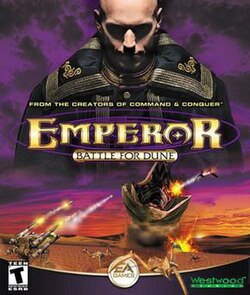Plot
The Spacing Guild has presented the three remaining Houses (the same as those in the previous games: House Atreides, House Harkonnen and House Ordos) with a unique challenge: a war of assassins on the planet Arrakis. Whichever House wins the war will become the new leader of the Landsraad, and its leader the new Padishah Emperor, Emperor of the Known Universe.
During the campaign, the Tleilaxu are scouring Arrakis with hidden motives, with various probes spotted collecting flesh samples from dead sandworms. After the last battle with any one of the opponent Houses on their home planet, the Spacing Guild leaves the victorious House stranded on the enemies' conquered homeworld, attempting to control Arrakis with House Tleilaxu by genetically engineering an Emperor Worm with immense psychic powers empowered by Lady Elara. They release a mind influencing drug in the remaining forces' water supply on Arrakis to make them slaves under the Guild. A last-ditch attempt must be made back on Arrakis to destroy the Emperor Worm before he awakes, by using the Smugglers Guild to get back to Arrakis. The Emperor Worm is destroyed, and the Spacing Guild's plan is foiled. The victorious house regains control of Arrakis and the spice melange and proclaims their side's leader Emperor of Dune.
Subplots
While each campaign has the story ultimately culminating up to the battle with the Emperor Worm, the three campaigns have subplots revolving around each faction's intents to conquer Arrakis.
House Atreides' campaign involves regaining the trust of the Fremen, with whom they have had an uneasy relationship due to unspecified past events. Many of the starting missions revolve around forming an alliance with the Fremen. Later on in the campaign, a party of Fremen diplomats are sent to Caladan, where they and the Duke Achillus are under attack by Tleilaxu soldiers. This attack is eventually thwarted and the Fremen pledge their allegiance to House Atreides. The general benevolence of House Atreides is apparent in their motivation for each map's campaign and they have little to no ulterior motives in lending assistance to any of the factions on Arrakis.
House Harkonnen's campaign revolves around the ailing Baron Rakan and his two sons, Gunseng and Copec, who both vie to take the Baron's place upon his death. Copec and Gunseng are at each other's throats, competing for the Baron's favor as the former's grew larger and the latter's days grow shorter. Gunseng eventually goes to Arrakis to oversee the spice mining. Copec grows impatient, however, and poisons Rakan's food. Copec assumes the title, and goes to Arrakis to have his brother swear allegiance to his new baron. Believing that Copec has usurped the title, Gunseng openly rebels against him. The player character chooses to either side with Gunseng or Copec, and both opposing factions battle on Giedi Prime. Depending on who emerges victorious, the game will then feature Gunseng or Copec as the reigning baron of House Harkonnen.
House Ordos' campaign revolves around their ability to create gholas. The house eventually creates a ghola of the deceased Emperor Shaddam Corrino, who will serve as a puppet emperor subservient to House Ordos. Ordos motives are typically insidious in that they attempt to manipulate many of the subhouses (Fremen, Sardaukar, Smugglers) into conflict with the major houses they are fighting, using gholas and other forms of treachery to thwart any attempts at alliance among their enemies and secure alliances for House Ordos. The Ordos are led by the Executrix, four beings that share a single mind and communicate only through a creature known as the "Speaker". The Ordos are calculated in their thinking, almost machine-like. Advising the "Commander" (player) is the equally cold female Mentat Roma Atani.
There are also subplots within subhouses and factions on Arrakis. Ix and the Tleilaxu have made it clear that they cannot be united, and force the player to choose one or the other, though it is possible to have the support of two. A Sardaukar coffin containing a trooper in suspended animation can sometimes be found in the battlefield. These troopers usually ally themselves with the faction that awakens them.

